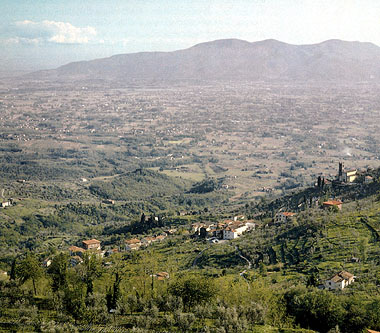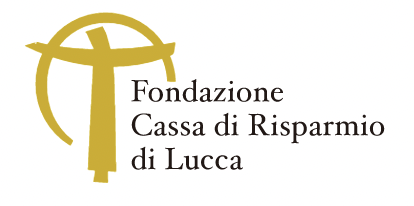
The Etruscan presence in the Piana di Lucca is documented since the Iron Age when small groups of Villanovans, farmers and fishermen, settled along the course of the Auser river. Merchants from southern Etruria who were trading by sea with the Ligurians began to appear on the Versilia coast from the end of VIIIth century B.C. and during all the VIIth. Near the landingplaces necessary for coasting commercial settlements began to develop and from here goods and, in general, Etruscan culture began to spread over the surrounding areas.
From the end of the VIIth century B.C. Pisa, by then an important Etruscan centre, extended its influence to a vast territory including Versilia and Piana di Lucca. In these two areas, between the Archaic Age and the Classical Age, a number of new settlements were established in the plain or on alluvial terraces to exploit intensively the agricultural and natural resources. During the Vth century B.C. the middle valley of the Serchio was also colonised by Etruscans, while in Piana di Lucca, alongside the traditional riverside settlements, new ones were founded in the high, strategic positions that made it was possible to control the territory and its roads. Large scale floods towards the end of the Vth century forced the population to abandon the plain.
Between the end of the IVth century B.C. and the beginning of the IIIrd the mountainous regions, i.e. the Apuans and the Apennine, were occupied by Ligurian peoples, while the Etruscan settlements of Versilia moved from the alluvial terraces towards the hills, where they were better protected. In the territory of Lucca the Etruscan villages gathered along the edges of the plain, which was at the time probably still uninhabitable.
In the course of the IIIrd century B.C. relations were established between the Etruscans and the Ligurians as they traded their products; however towards the end of the century Rome's expansionism upset this delicate balance. The raids of the Ligurians who descended onto the plain arriving as far as Pisa, an ally of Roma, prompted the intervention of the Roman army that ended with the defeat of the Ligurians and the foundation of the colonies of Lucca (180 B.C.) and Luni (177 B.C.).
(text by Susanna Bianchini-Fabio Fabiani)
Details:
The variety of landscapes and natural resources allowed the local population to practice different activities.
The main resource, agriculture, provided cereals and vegetables, as shown by the seeds of broad beans found in the settlement of Bora dei Frati and also, with all probability, wine and olive oil. Animal husbandry was also widespread to judge from the finds at Montecatino in Valfreddana where cattle, necessary also for work on the fields, were most certainly eaten together with goats, sheep that provided also milk and wool, pigs, and sometimes even dogs.
In addition to agriculture and animal husbandry, hunting and fishing were common in particular in the marshlands of the coast and of the interior, where weights used for nets have often been found.
The Apuan Alps, rich in natural resources, provided marble and minerals. Marble, in particular, led to the early development since the Archaic Age of a local trade and art in nearby Pisa. Commerce also played an important role in the local economy; this is especially true for the villages near the coast or along waterways like the Auserriver.
The numerous finds of recipients used for transport (amphorae) and of imported pottery confirm the existence of long range commercial relations.
Among the most common domestic activities were certainly spinning and weaving, practised by the women and documented by numerous finds of reels, spindles and loom weights of terracotta; among the textiles, together with wool, the use of linen is also attested (Bora dei Frati). The identification of places of cult is all we know about the religious life. In Pisa, inside the town, there were probably some proper religious buildings, while in the rest of the territory, together with domestic cult, small sanctuaries dedicated to rural divinities certainly existed; the intense frequentation of the Castelvenere cave instead is probably connected to the worship of water.
A small number of inscriptions on vases, scattered on the territory, are the only evidence we have of writing and of the diffusion of literacy among the population (Ponte a Moriano).
Burial areas, the necropoleis, were next t the settlements. The discovery of a necropolis often suggests the existence of an otherwise unknown settlement helping us to reconstruct the settlement pattern.
The local burial rite, substantially unchanged during the whole Etruscan period, was cremation: the ashes and charred remains were collected in a vase, often covered with an overturned bowl, and simply buried or first covered to protect it together with any grave goods and then buried.
The protective cover consisted, locally, of a large vase, cut in half and placed upside down (Via Squaglia; Villa Mansi) or, less frequently, of a case made of stone slabs (Via del Poggione). The grave goods, found only in some tombs, could be composed of personal objects like the rich jewels from the tomb of Rio Ralletta di Capannori, tableware used for banquets and arms, as in the Archaic Age Versilian tomb of Via del Poggione and in the Hellenistic tomb of Ponte a Moriano. Inside the necropoleis the tombs, single or by groups, were often marked by a tombstone ('cippo') made of Apuan marble; the typical and most widespread form, with a conical body and a bulb at its base for fixing it into the ground, is known as 'cippo a clava' (Via del Poggione).
During the entire Etruscan period perishable materials such as wood, straw and clay prevailed as building material. Therefore the proposed reconstruction of dwellings is based upon scanty rests such as holes for lodging wooden piles.
In the more ancient period, the dwellings in the plain of Lucca (Chiarone), isolated or inside modest family settlements, consisted of simple huts supported by wooden posts with walls made of branches and covered with clay.
Alongside this traditional from of dwelling, constructions with walls built upon a solid base of rubble and clay (Tempagnano; Acquarella) appeared; the walls could still be made of wooden posts, branches and plaster or simply of unbaked clay.
For the roofing, always of perishable material, tiles were introduced to reinforce particularly stressed parts.
In the Hellenistic Age the building technique remained on the whole unchanged, though the placement of settlements on hills imposed the frequent cutting and levelling of rocks in the ground (Bora dei Frati; Romito di Pozzuolo); in the marshland, for example in the settlement of Ponte Gini di Orentano (Pisa), we find traces of drainage works with the help of wooden piles.
The usual domestic activities were carried out under roofs and small porches, or around hearths (Bora dei Frati); large vases, sometimes buried, were used for storage purposes. Besides, wells (S. Rocchino), roads or public spaces (Tempagnano) were utilities essential for the community. Sporadic finds also show that inside the dwellings there were small domestic cult places (so called "larari"; Chiarone).





